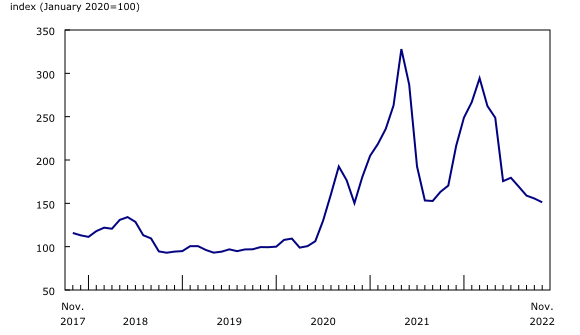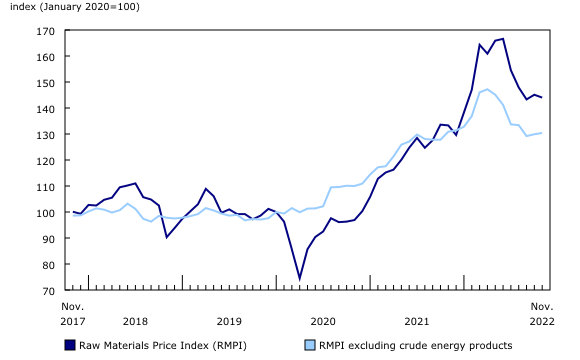Industrial product and raw materials price indexes, November 2022
Released: 2022-12-19
Prices of products manufactured in Canada, as measured by the Industrial Product Price Index (IPPI), declined 0.4% month over month in November and were 9.7% higher than in November 2021. Prices of raw materials purchased by manufacturers operating in Canada, as measured by the Raw Materials Price Index (RMPI), fell 0.8% on a monthly basis in November 2022 and increased 8.0% year over year.
Industrial Product Price Index
In November, the IPPI declined 0.4% month over month and increased 9.7% on a year-over-year basis.
Energy and petroleum products (-2.7%) led the decrease in monthly IPPI. Compared with November 2021, prices were up 40.8% in November 2022. Among refined petroleum energy products (-2.7%), prices fell for finished motor gasoline (-6.8%) and diesel fuel (-1.1%). Market data show that this downward trend continues into the first half of December. The decline in prices for these refined products is related to both inventories and demand. US commercial inventories of finished motor gasoline and distillate fuel oil both grew from October to November. US weekly product supplied of motor gasoline, a measure of demand, was down 6.1% in November compared with the same month a year earlier. Lower prices for crude oil also played a part in the observed price decreases for refined energy products.
Prices for motorized and recreational vehicles fell 0.6% in November 2022. Lower prices for motor vehicle engines and motor vehicle parts (-1.1%) and aircraft engines, aircraft parts and other aerospace equipment (-1.9%) were mainly responsible for the decrease. In November, the Canadian dollar appreciated 1.9% against the US dollar. As many prices in this category are reported in US dollars, the movement in the exchange rate contributed to the monthly price decrease.
The price of softwood lumber (-2.8%) fell for a fourth consecutive month in November. Year over year, softwood lumber prices were down 11.3%, the largest decline since June (-38.8%). Lower lumber prices were partially attributable to a cooling housing market in the US and Canada amidst rising interest rates. The average interest rate on a 30-year fixed mortgage in the US was 6.8% in November, more than double what it was in November 2021. In the US, the primary market for Canadian softwood lumber, October housing starts fell by 4.2% month over month and 8.8% year over year. Market indicators show that the downward trend in lumber prices continued into early December. Amidst this falling demand, three large Canadian lumber producers have announced production downtime.
Higher prices for primary non-ferrous metal products (+3.7%) largely offset the downward trend in IPPI in November. Prices increased for unwrought gold, silver, and platinum group metals, and their alloys (+3.9%), unwrought nickel and nickel alloys (+13.9%), unwrought copper and copper alloys (+3.2%), as well as unwrought aluminum and aluminum alloys (+2.2%). Metal prices were partially influenced upward by a weakening US dollar in November. Nickel market prices at the London Metal Exchange were volatile within the month of November, as the first half of the month saw a 40% rally and included a day where trading breached the 15% daily limit. In response, the London Metal Exchange announced higher initial margins on nickel trading, as well as enhanced monitoring of trading activities. Although the non-ferrous metal category increased on a monthly basis, prices were 0.6% lower compared with November 2021. This was the fifth consecutive year-over-year decline for the group.
Raw Materials Price Index
In November, the RMPI fell 0.8% on a monthly basis and increased 8.0% year over year.
Crude energy products dropped 2.2% in November, mainly on lower prices for conventional crude oil (-3.6%). Synthetic crude oil (-2.5%) was also down. The decrease was partially due to expectations of lower global economic activity. China's Purchasing Manager's Index, an indicator of manufacturing activity, fell 1.2% in November, which reinforced these concerns.
Prices for natural gas were up 30.3% in November. This month-over-month movement was the largest on record for this series, which began in January 1980. It was a result of low prices in October 2022. November prices for natural gas returned to a level just under what was observed in June. Demand for Canadian natural gas is driven both by domestic consumption and by exports to the US. Natural gas usage and prices also tend to show seasonal increases in the winter months, as it is used for heating.
Canadian natural gas prices have been volatile in 2022, as maintenance and bottlenecks resulted in situations where it was not possible to transport Canadian product, which resulted in sharp price drops. In November, the average reference price of natural gas at Canada's AECO hub was approximately $4.15 USD/MMBtu. To compare, the US reference price at Henry Hub was $5.45 USD/MMBtu, the European reference price was $35.72 USD/MMBtu, and the reference price in Japan for liquefied natural gas (LNG) imports was $21.74 USD/MMBtu. On November 30, the Government of Canada approved the NOVA Gas Transmission Limited West Path Delivery 2023 pipeline project with 34 binding conditions related to environmental protection, the involvement of Indigenous people in monitoring, safety and integrity, and employment and training. Looking forward towards our next reference month, a report from the US Energy Information Administration shows that in early December, cold weather and increased consumption in Western Canada slightly drove down export flows to the US western region.
Prices for metal ores, concentrates and scrap rose 1.3% in November, mainly due price increases for gold, silver, and platinum group metal ores and concentrates (+4.1%).
Note to readers
The Industrial Product Price Index (IPPI) and the Raw Materials Price Index (RMPI) are available at the Canadian level only. Selected commodity groups within the IPPI are also available by region.
With each release, data for the previous six months may have been revised. The indexes are not seasonally adjusted.
The IPPIreflects the prices that producers in Canada receive as goods leave the plant gate. The IPPI does not reflect what the consumer pays. Unlike the Consumer Price Index, the IPPI excludes indirect taxes and all costs that occur between the time a good leaves the plant and the time the final user takes possession of the good. This includes transportation, wholesale and retail costs.
Canadian producers export many goods. Canadian producers often indicate goods' prices in foreign currencies, especially in US dollars, which are then converted into Canadian dollars. This is particularly the case for motor vehicles, pulp and paper products, and wood products. Therefore, fluctuations in the value of the Canadian dollar against its US counterpart affect the IPPI. However, the conversion to Canadian dollars reflects only how respondents provide their prices. This is not a measure that takes into account the full effect of exchange rates.
The conversion of prices received in US dollars is based on the average monthly exchange rate established by the Bank of Canada and available in Table 33-10-0163-01 (series v111666275). Monthly and annual variations in the exchange rate, as described in the release, are calculated according to the indirect quotation of the exchange rate (for example, CAN$1 = US$X).
The RMPI reflects the prices paid by Canadian manufacturers for key raw materials. Many of those prices are set on the world market. However, as few prices are denominated in foreign currencies, their conversion into Canadian dollars has only a minor effect on the calculation of the RMPI.
Products
The product "Industrial Product Price Index: 2021 Annual Review" is now available. This document is a review of how producer prices, as measured by the IPPI, changed in 2021 compared with 2020. In 2021, a multitude of factors influenced prices, many of which stemmed from the COVID-19 pandemic. Economies reopened slowly, as lockdowns were lifted and vaccinations became available, driving up demand.
Statistics Canada launched the Producer Price Indexes Portal as part of a suite of portals for prices and price indexes. This webpage provides Canadians with a single point of access to a variety of statistics, and measures related to producer prices.
The video "Producer price indexes" is available on the Statistics Canada Training Institute webpage. It introduces Statistics Canada's producer price indexes—what they are, how they are made, and what they are used for.
Addition of a new table and additional data
Effective February 28, 2022, table 18-10-0272-01 has been added to the Statistics Canada website featuring regional indexes for select refined petroleum products. In addition, tables 18-10-0266-01 and 18-10-0268-01 now contain data for select 6- and 7-digit North American Product Classification System series.
Next release
The industrial product and raw materials price indexes for December will be released on January 18, 2023.
Contact information
For more information, or to enquire about the concepts, methods or data quality of this release, contact us (toll-free 1-800-263-1136; 514-283-8300; infostats@statcan.gc.ca) or Media Relations (statcan.mediahotline-ligneinfomedias.statcan@statcan.gc.ca).
- Date modified:





